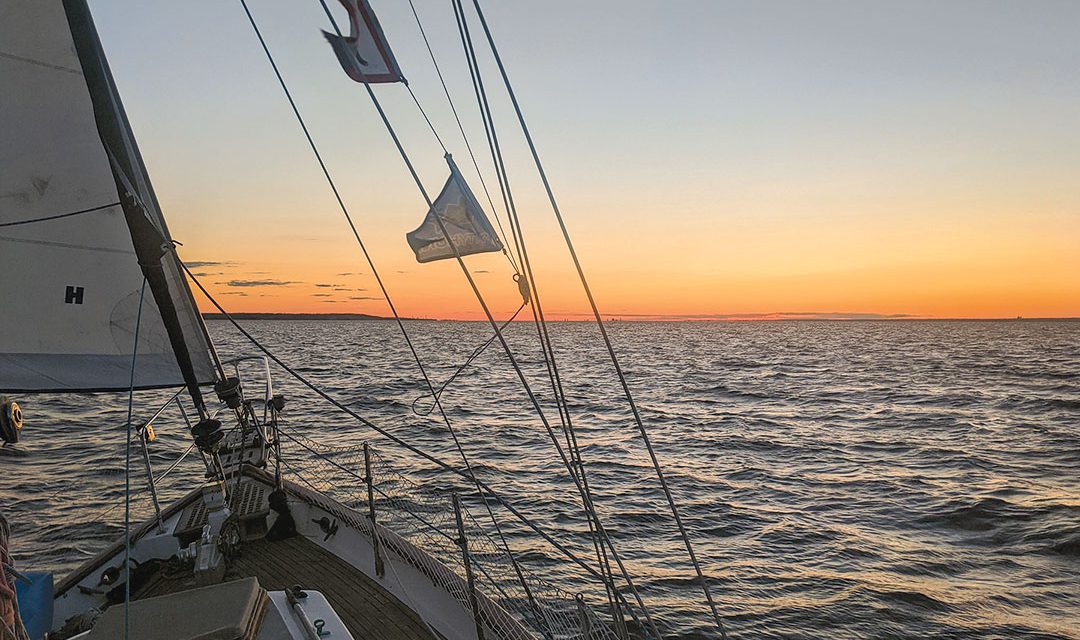May 2012 Landfalls with Bull’s-Eye Precision
From how far away can you see a lighthouse from the deck of your boat? Well, it depends.
It depends on the height of the lighthouse above sea level, the height of your eye above sea level, and the weather.
The theoretical distance at which you can see an object on a clear day is limited by the curvature of the earth, and you can easily calculate this distance from first principles with a little high-school math.
The simple formula, ignoring refraction (caused by light bending as it crosses regions of varying air density between the observed object and the eye) is:
D = ?(2Rh)
where D is the distance to the object, R is the radius of the Earth, and h is the height of the object.
Note that D, R, and h must be in the same units (feet or kilometers or miles, etc.). If we want the distance in nautical miles and the height in feet, we must use some conversion factors.
According to NASA, the average radius of the Earth is 6,371 kilometers. That’s 3,440 nautical miles, so R = 3,440.
To get h into nautical miles we must divide it by 6,076 (by international convention, the number of feet in a nautical mile). This gives us:
D = ?(2 × 3440 × h/6076) = ?(1.132h) = 1.064 ?h
This calculation assumes no refraction. Because under most atmospheric conditions light bends toward Earth’s surface, the distance to the actual horizon you see is a little longer.
Another website http://mintaka.sdsu.edu/GF/explain/atmos_refr/horizon.html , presents a calculation for adjusting for refraction. It assumes a typical value for the curve the light beam makes as being 1/7 that of the Earth’s surface. In short, that means increasing the value used for the Earth’s radius by 7/6.
So, 3440 × 7/6 ? 4013. If we insert that into the equation we get:
D = ?(2 × 4013 × h/6076) = ?(1.321h) = 1.149?h
The same website also refers to an “old rule” used for calculating horizon distance that states that 7 × height (in feet) ? 4 × (D squared), where D is in statute miles, or:
D = ?(7 × h/4)
To get D in nautical miles, we have to correct:
D = 5280/6076 × ?(7 × h/4) . . . a statute mile is 5,280 feet
D = .869 × ?(1.75h) = .869 × 1.322?h = 1.15 ?h
Apparently, this is the “old rule” used by Bowditch (American Practical Navigator) for calculating the values in Table 8, “Distance of Visibility of Objects at Sea” (at least up until 1943).
A British book, Little Ship Navigation (1949), uses Inman’s Tables for values for “Distance of the Sea Horizon.” Inman apparently used the same rule as Bowditch: you only have to look at the number next to the 100ft object height (11.5 miles).
Little Ship Navigation suggests using 8/7 (1.143) as a multiplier of ?h if the navigator doesn’t have access to the table. This method dates to the days before electronic calculators, so it was important to keep the numbers simple.
In Dutton’s Navigation and Piloting, 12th Ed. (1969), the coefficient used is 1.144 and the reader is also referred to Table 8 in Bowditch.
Coastal Piloting, published by the U.S. Coast Guard Auxiliary (1983) uses 1.14.
Reed’s Nautical Companion (2003) uses 1.15.
Chapman (Piloting Seamanship & Small Boat Handling), certainly as far back as the 57th Edition (1985), uses 1.17 as the multiplier and this number appears on several websites (Boatsafe, for example) that have presumably picked it up from the same source.
The National Geospatial-Intelligence Agency (NGA) has a calculator in the Maritime Safety Information pages (http://msi.nga.mil/NGAPortal/MSI.portal) that also uses 1.17 (click on Nautical Calculators in the left-hand column, then on “menu options.”)
So, why do different sources of navigational information use two different coefficients for calculating horizon distance? Good question. Possibly they use a different correction for diffraction.
When it comes down to you and your boat, it’s of little consequence which value you use. The difference between 1.14 and 1.17 is about 2.5 percent. If you expected to see a light at a range of 15 miles and it was instead 14.6 miles, you would have to sail .4 miles farther before raising it. At 5 knots (one mile every 12 minutes) that would take another 4.8 minutes . . . not long enough for your hair to turn gray.
Note that the refraction correction is an “average.” Atmospheric conditions can have a much greater effect than 2.5 percent on when (or if) you will pick up a beam from a lighthouse when you are at sea.
More references:
https://en.wikipedia.org/wiki/Horizon
https://boatsafe.com/tools/horizon.htm





